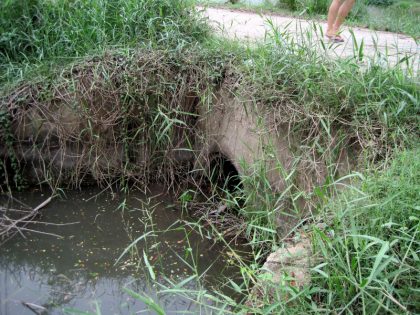 Location
Location
Sub-district Ban Yaang, District: Sao Hai, Province: Saraburi, Thailand
Community Description
The sub-district Ban Yaang has approximately 2,500 community members residing in fourteen villages. This water treatment project will be carried out at a pond which is located within village number 10 but is also easily accessible by members of villages 8 and 9.
There are about 400 people living in villages 8, 9, and 10 combined. The pond is a source of aquaculture, mainly to raise fish for food, for many of the people in villages 9 and 10. In addition, the pond is used for washing clothes and swimming.
The pond is enclosed within a limited space without a stream or waterfall to ripple the surface, thus preventing aeration. Oxygen depletion has increased due to the buildup of waste and organic loads from the surrounding homes and chemical spills from the rice fields located nearby.
 Project Description
Project Description
This project is to remediate the pond in Ban Yaang to improve the quality of the water so that the pond can be safely used.
Under the direction of the village leaders, the pond water treatment committee, with the guidance of the Peace Corps volunteer, an “action plan” has been developed that combines methods of proper aeration/water circulation and water quality management to reduce the severity of the pollution in the water and the dissolved oxygen fish kills.
The water will be tested for oxygen levels, chemicals, and PH levels. A training session will be held with participating village members and the pond committee during which EM mud balls will be made. These are designed to help promote “sludge–eating microbial activity” .
The EM technology uses naturally occurring microorganisms to purify water which in turn will revive aquatic life. The training is an important aspect of water management because technology will have to be applied once every 6 months.
 Subsequent plans have been developed for water aeration, to be implemented upon obtaining additional funding. A combination of continuous EM mud ball treatment and surface aeration, have been determined to be the most sustainable treatment protocol for this pond.
Subsequent plans have been developed for water aeration, to be implemented upon obtaining additional funding. A combination of continuous EM mud ball treatment and surface aeration, have been determined to be the most sustainable treatment protocol for this pond.
Plans for aeration include building a surface aeration machine, utilizing the help of engineers from the local technical college.
Alternatively, a paddle wheel aerator will be purchased. Paddlewheel aerators utilize air-to-water contact to transfer oxygen from the air in the atmosphere to the pond. They are most often used in the aquaculture field.
The funds provided by Appropriate Projects will mostly be used for all aspects of the training, including labor and materials, during which over 300 EM mud balls will be made. In addition, the funds will be used for the purchase of equipment for testing water quality.
As part of the community participation, community members will be educated on the harmful effects of contaminating the pond with trash and hazardous waste, and steps to be taken to keep these pollutants from entering the water.
Project Impact
About 400 people will benefit from the project, consisting of about 120 people who live around the pond, plus the remainder who have access to and use the pond at various times.
Peace Corps Volunteer Directing Project
Zerina Borhan
Comments
This project will restore the safe use of the pond for activities such as washing clothes, catching fish, and swimming.
Training the village members to make the EM balls will create a sustainable treatment process. A full solution will be accomplished upon the addition the contemplated aeration method.
Dollar Amount of Project
$555.00
Donations Collected to Date
$555.00
Dollar Amount Needed
$0.00 – This project has been fully funded, through the generosity of The Soneva SLOW LIFE Trust as a part of their Clean Water Projects initiative, with the help of friends and family of Zerina.
We encourage others to continue to donate using the Donate button below, and we will notify Peace Corps Volunteer Zerina Borhan of your donation. Additional funds will be used to fund the next project by Zerina and/or those other PCVs in the country of service.
This project has been finished. To read about the conclusion of the project, CLICK HERE.